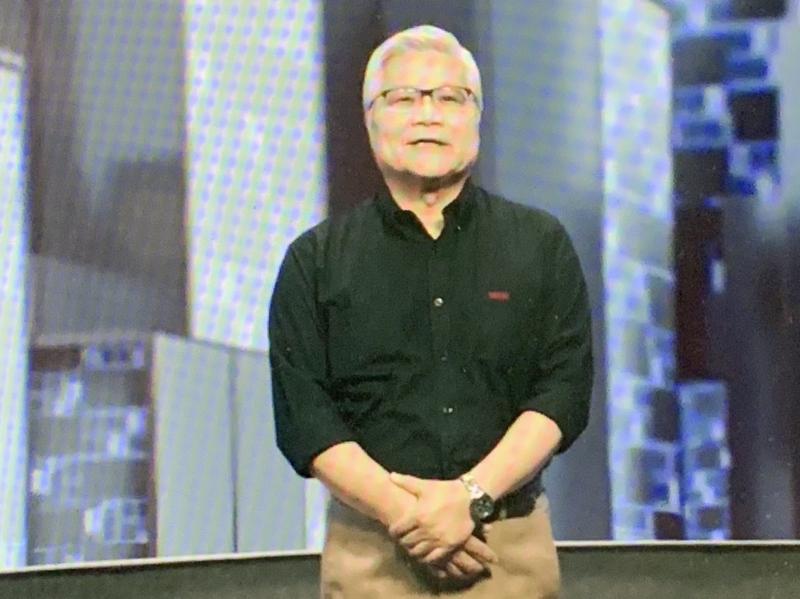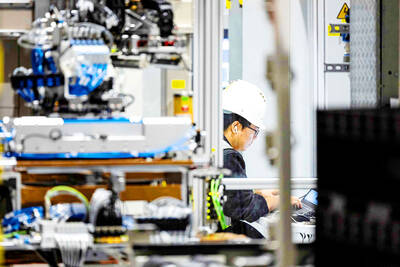Taiwan Semiconductor Manufacturing Co (TSMC, 台積電) yesterday unveiled the layout of its new fab in Arizona and reiterated its determination to ramp up advanced 5-nanometer chip production in 2024.
The company said that construction of Fab 21, in which it would invest US$10 billion to US$12 billion, has begun on a 445 hectare plot in Phoenix.
“As we expect demand for 5-nanometer [chips] will be strong and sustainable in the long term, we have made the Arizona fab, Fab 21, one of the 5-nanometer manufacturing sites,” TSMC chief executive officer C.C. Wei (魏哲家) told the company’s annual technology symposium.

Photo: Grace Hung, Taipei Times
The chipmaker has shipped more than 500,000 5-nanometer chips from its Fab 18 in Tainan since the technology became available last year, thanks to robust customer demand for smartphones, 5G applications, artificial-intelligence (AI) applications, networking devices and high-performance computing devices, Wei said.
The first phase of the Arizona fab would have an installed capacity of 20,000 wafers a month, TSMC said.
In January, the chipmaker said that further expansion would depend on market conditions and US government support.
TSMC yesterday introduced the technology for its new N5A process to produce 5-nanometer chips for automotive applications such as AI-enabled driver assistance and the digitization of vehicle cockpits.
Production using the N5A process is scheduled to be available in the third quarter of next year, Wei said.
The chipmaker said that its 3-nanometer technology would be the world’s most advanced technology when volume production begins in the second half of next year.
Its fabs in Tainan would be its major manufacturing sites for 3-nanometer chips, TSMC said.
To expedite mass production of 3-nanometer and 2-nanometer chips, TSMC is transforming its 2-nanometer research centers in Hsinchu into sites for initial production of new-generation chips, it said.
TSMC has been boosted capacity to catch up with customers' rising demand,expecting that its advanced technology capacity would expand at a compound annual rate of 30 percent from 2018 to this year.
Among advanced technologies,7-nanometer chip capacity would have increased fourfold until this year since 2018, TSMC senior vice president Y.P. Chin (秦永沛) told the symposium.
Five-nanometer chip capacity would quadruple until 2023 from last year’s level, he said.
The company is also expanding its advanced chip testing and packaging capacity to cope with growing demand, Chin said.
TSMC is building its fifth fab in Miaoli County’s Jhunan Township (竹南), which would offer the most advanced 3D packaging technology of system-on-integrated-chip in the second half of next year, he said.

CHIP RACE: Three years of overbroad export controls drove foreign competitors to pursue their own AI chips, and ‘cost US taxpayers billions of dollars,’ Nvidia said China has figured out the US strategy for allowing it to buy Nvidia Corp’s H200s and is rejecting the artificial intelligence (AI) chip in favor of domestically developed semiconductors, White House AI adviser David Sacks said, citing news reports. US President Donald Trump on Monday said that he would allow shipments of Nvidia’s H200 chips to China, part of an administration effort backed by Sacks to challenge Chinese tech champions such as Huawei Technologies Co (華為) by bringing US competition to their home market. On Friday, Sacks signaled that he was uncertain about whether that approach would work. “They’re rejecting our chips,” Sacks

NATIONAL SECURITY: Intel’s testing of ACM tools despite US government control ‘highlights egregious gaps in US technology protection policies,’ a former official said Chipmaker Intel Corp has tested chipmaking tools this year from a toolmaker with deep roots in China and two overseas units that were targeted by US sanctions, according to two sources with direct knowledge of the matter. Intel, which fended off calls for its CEO’s resignation from US President Donald Trump in August over his alleged ties to China, got the tools from ACM Research Inc, a Fremont, California-based producer of chipmaking equipment. Two of ACM’s units, based in Shanghai and South Korea, were among a number of firms barred last year from receiving US technology over claims they have

It is challenging to build infrastructure in much of Europe. Constrained budgets and polarized politics tend to undermine long-term projects, forcing officials to react to emergencies rather than plan for the future. Not in Austria. Today, the country is to officially open its Koralmbahn tunnel, the 5.9 billion euro (US$6.9 billion) centerpiece of a groundbreaking new railway that will eventually run from Poland’s Baltic coast to the Adriatic Sea, transforming travel within Austria and positioning the Alpine nation at the forefront of logistics in Europe. “It is Austria’s biggest socio-economic experiment in over a century,” said Eric Kirschner, an economist at Graz-based Joanneum

France is developing domestic production of electric vehicle (EV) batteries with an eye on industrial independence, but Asian experts are proving key in launching operations. In the Verkor factory outside the northern city of Dunkirk, which was inaugurated on Thursday, foreign specialists, notably from South Korea and Malaysia, are training the local staff. Verkor is the third battery gigafactory to open in northern France in a region that has become known as “Battery Valley.” At the Automotive Energy Supply Corp (AESC) factory near the city of Douai, where production has been under way for several months, Chinese engineers and technicians supervise French recruits. “They